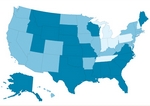business
How states will shape health reform
■ Attention over the last three years has been focused firmly on national health system reform, but state-level regulation of health insurers remains critical.
By Emily Berry — Posted Aug. 29, 2011
- WITH THIS STORY:
- » Rate regulation: all over the map
- » Mixed state laws
- » External links
- » Related content
The bill was passed and signed into law in Washington, but much of health system reform, particularly where it affects health insurance, is taking shape in places such as Sacramento, Calif., Harrisburg, Pa., and Providence, R.I. -- state capitals.
Most often, pundits and politicians talk about the Patient Protection and Affordable Care Act as if it is a blessing or a curse from the federal government. But especially when it comes to health insurance regulation, state legislators and regulators hold much of the power to enforce or ignore reform.
States are choosing either to overhaul insurance company oversight or to maintain a hands-off policy. That means physicians ought to direct their concerns to their state capitals, health policy experts said.
Simply stated, "States are where it's at," said Sabrina Corlette, research professor at Georgetown University's Health Policy Institute.
"For largely political reasons, the law has been characterized as somehow a big federal takeover of our health system. That's a myth. ... The law is heavily dependent on states, and in many cases almost exclusively dependent on states not just to set rules, but provide oversight and enforcement."
Under the health reform law, state lawmakers and regulators may establish a health insurance exchange or allow the federal government to run one for them. They may spend a lot of time and money reviewing health insurers' rate increases -- or leave oversight to the new Center for Consumer Information and Insurance Oversight, part of the federal Centers for Medicare & Medicaid Services.
So far, the states' actions have ranged from total rejection of any enforcement of the reform law (as in Idaho, where Gov. Butch Otter ordered state employees not to spend time or money enforcing the law) to a flurry of state regulation meant both to enforce and extend changes set out in the federal law.
"States are the primary locus of regulation," Corlette said. "Only if the state is unwilling or unable to regulate insurance, only then would the federal government, through HHS, step in."
The American Medical Association has continued to work with state regulators while advocating for physicians in Washington.
"States are playing a major role in implementation of the health reform law," said AMA President Peter Carmel, MD. "While the law established some insurance market reforms directly, it also established a framework for many other issues, such as health insurance exchanges, where states have wide latitude in how they are implemented. The AMA has been advocating to national groups, such as the National Assn. of Insurance Commissioners, and collaborating with state medical associations to ensure that the intent of the health reform law -- to meaningfully improve the health care system -- comes to fruition in state capitals."
Rate regulation
One change that most rankles insurers is the insertion of federal authority into the premium rate approval process. But in most states, the buck will still stop at the state insurance commissioner's desk.
The health reform law allows federal authorities to examine what insurers are charging and establishes federal authority over "unreasonable" rate increases. But the first mechanism for accomplishing that was to send money to state insurance departments. A round of grants for $1 million each began the overhaul of rate review.
The law makes $250 million available to states to enhance rate review processes. Forty-four states and the District of Columbia have accepted the grants, hiring experts to review insurers' filings and making insurers' filings public.
CCIIO has credited the grants and additional scrutiny with withdrawn rate increase requests -- as in California -- and rejected or lowered requests, as in Rhode Island and Connecticut.
Federal officials said they will intervene when insurers try to impose extreme increases, but most intervening will fall to state regulators.
In July, HHS released a list of states with "adequate" review processes. Where states' processes are inadequate, CCIIO will do its own reviews of any rate increases that average 10% or more.
Much is at stake for physicians regarding rate increases. The higher premiums go, the more unaffordable insurance becomes, and the fewer patients who are insured. Physicians in private practice also want to be able to afford to offer health benefits to their own employees, said Yul Ejnes, MD, an internist from Cranston, R.I., who is chair of the board for the American College of Physicians.
Medical spending minimums
After health insurers set their premium rates, the amount of each dollar they spend on paying for their members' visits to the doctor, prescriptions and hospital stays rather than administrative expenses and profits, varies. But there are new rules under the health reform law.
Before the law was enacted, in some states, the minimum was as low as 65%, and others had no floor for a medical-loss ratio.
Beginning this year, the law requires insurers to reach an 80% medical-loss ratio in the small group and individual markets, and an 85% medical-loss ratio in the large group market. If they do not, they must pay rebates to customers the following year.
HHS released the interim final rules for medical-loss ratios in November 2010, and it will be in charge of verifying whether insurers have met the minimum. But for the next few years, states will affect the way reform is implemented by delaying the effective date of the minimums. Without a waiver in their states, insurers will have to pay rebates in 2012 if they didn't hit the minimum medical-loss ratio in 2011.
States hold that power because under the health reform law, they are allowed to apply for waivers from medical-loss ratio rules if they believe insurers will leave their state and the availability of insurance will be threatened by the requirement.
As of mid-August, 15 waivers had been requested and were granted at least in part in five states -- Iowa, Kentucky, Maine, Nevada and New Hampshire -- and denied in one state, North Dakota. Applications are pending for eight other states.
North Dakota State Rep. George Keiser, a Republican from Bismarck who is president of the National Conference of Insurance Legislators, said he disagrees with the 80% minimum.
If the courts rule the health reform law unconstitutional, that's one element he would expect to see revert to the state's own rules. But that isn't to say reforms would disappear, he said.
"We will continue to work toward developing a system that works. In North Dakota, it likely would not look like the federal system that has been imposed on us."
Health insurance exchanges
Under the health reform law, states can establish their own health insurance marketplaces, or they may let the federal government run them. HHS also will allow for some plans to offer coverage in multiple states -- a provision that the state insurance commissioners' group said it hoped would not give already large, national plans an advantage over smaller, regional competitors.
Corlette said federal officials are pushing for states to take charge of their exchanges. As of mid-August, 13 states had approved legislation establishing health insurance exchanges. Two others, Massachusetts and Utah, already had exchanges. Twenty-six states have won federal grants to help establish their exchanges, but the exchanges are supposed to be self-supporting by 2015. In most cases, states are expected to pay for the exchanges by charging insurers fees.
Kansas and Oklahoma returned federal "early innovators" grant money meant to help them establish health insurance exchanges. Kansas did not rule out establishing a state exchange but rejected the "strings attached" to the early innovators grant. Oklahoma officials said they would create a "Health Insurance Private Enterprise Network" funded by the state and "private resources" rather than federal funds.
"If the state is unwilling or unable to do it, they're willing to work with a state, so if a state ever wants to come back and do it, they can," said Georgetown's Corlette. "I think there's been a heavy emphasis on states owning and designing and implementing their own exchange."
Keiser said the public -- and even state legislators -- probably don't realize the power the states have to tailor their exchanges.
"I think if you could take a randomly selected 500 state legislators and put them in a room and give them a test on the exchanges, they wouldn't pass," he said. "The general public is, I think, hoping this system doesn't screw anything up. They're holding us accountable to make sure that doesn't happen."
E. Richard Brown, PhD, director of the UCLA Center for Health Policy Research, said the exchanges give states leverage over insurers because they can limit participation to insurers who meet requirements for medical spending and offer certain benefits.
The fact that states have power to decide on a path is critical, Keiser said. "The federal government has given them a blueprint. The engineering and architectural design is still up the states."













